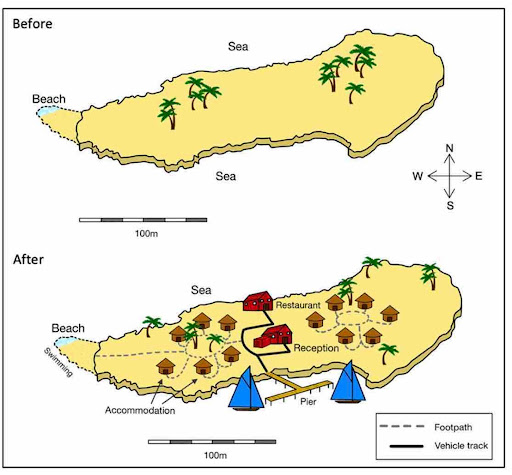IELTS Maps band nine Answer
The maps below show an island in 1980 and as it looks today.
Summarise the information by selecting and reporting the main features, and make comparisons where relevant.

These two maps show an island in 1980, prior to development, and today. Overall, the island has undergone significant changes to be able to accommodate and provide facilities to people. Today, the island boasts a reception, a restaurant, a pier and huts providing living quarters.
In 1980, the island was completely undeveloped. There were two clusters of trees, one to the east and one to the west. There was a beach to the far west; however, this beach had not yet been adapted for swimming.
Today, when people visit the island, they will be able to land at a southern pier and travel by vehicle track to the restaurant and reception at the centre of the island. To the east and west of the reception, twelve huts, which are connected by footpaths, have been built to accommodate visitors. A footpath leads to the beach in the west, which has undergone changes to make it more suitable for swimming. Finally, the trees have been replanted to be more spread out across the island.
How to answer IELTS map questions
Like any task one question, an IELTS map question requires you to give an introduction, overview and then two descriptive paragraphs. These questions typically feature the’ before and after’ of a certain place, so it is important to pay attention to which tenses you are using.
Grammar for IELTS Maps Questions
In this example question, the maps are from the 1980s and today, so I’ve used the past simple and present simple tense. The present perfect (twelve huts have been built) is also very useful because it is used when something has happened but we aren’t sure when.
Keep in mind that maps can also describe a change that will be happening in the future. Always make sure you read the question and
IELTS Maps Vocabulary
In this answer, you can find several pieces of grammar that are useful for describing maps. I have included a list of all the underlined words with definitions below.
- Development
- If there is development somewhere, someone has built things to improve that area.
- Boast
- If a person boasts, they are showing off. If an area ‘boasts’ something, it is more that the area has something good.
- Undeveloped
- If an area is undeveloped, it doesn’t have any development.
- Cluster
- A cluster is a group of things close together.
- North, East, South and West
- These are the four main directions. You’ll often see them as ‘N, E, S, W’ on the compass.
- Adapt
- If you adapt something, you make changes to it to make it more suitable for what you want.
- Land
- When a ship arrives at land, we can use the verb ‘land’ to describe it. This is the same as when aeroplanes arrive at a place.
- Southern
- This is the adjective version of ‘south’. You can also use ‘northern’, ‘eastern’ and ‘western’.
- Leads To
- If a path or road ‘leads to’ somewhere, this means it goes there.
- Spread Out
- If something is ‘spread out’, it covers an entire area rather than being concentrated.
In 1980s the population was too small in island now the population it as increased undergone significant changes its now developed and provide facilities to the people the island boast reception and restaurants because the population it has been high school fees in1980s there was a beach to the far west however this beach was not yet been adapted to swimming because population was not high so today If you visited the island people they are able to land and use the vehicle to track to the restaurant and reception at the centre of the island to the east and west of the reception
Hey Judith, thanks for this. You’ve picked out some good differences between the two maps. However,I would take a look at the full stops in this one. We’ll have a guide to task one structure in the near future, so keep an eye out for it 🙂
Tim